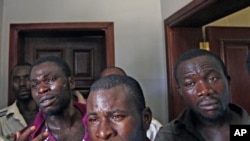About 3,000 sub-Saharan migrants remain stranded in the western Libyan town of Sebha, which has been under attack from anti-Gadhafi forces. Humanitarian agencies say food, water and shelter are in very short supply.
And getting worse…
Most of the migrants in Sebha, about 2,000, are from Chad. The rest are from the Horn of Africa, Middle East and Asia. And their numbers are growing.
They’ve been arriving in significant numbers in the past few days, as the situation in Sebha worsens. Reports that we’re getting from the ground from the Chadian deputy consular in Sebha is that overnight on Sunday to Monday there was fighting throughout the night.
“People clearly are feeling very scared and threatened and are seeking refuge where they can. And for migrants, it’s in our center,” said Jemini Pandya of the International Organization for Migration, which has a transit center in the town.
The IOM has now rented a compound adjacent to its center to try to accommodate their increasing numbers.
“The situation in the town is becoming increasingly difficult,” she said, “The food is becoming very scarce. There’s no running water and no electricity. And those conditions are replicated exactly in our center. IOM’s local staff, who are working there, are providing whatever food that they can get. But the fact that we’ve got ever increasing numbers of people arriving – combined with the fact that there’s less and less food available for us to buy in Sebha – means that it’s becoming an increasingly difficult and worrying situation for both us and for the migrants.”
No safe route out
IOM wants to evacuate the migrants by road, but it’s simply too dangerous. A safe corridor is yet to be negotiated and there is little fuel available for trucks. The flow of fuel to the town stopped when Tripoli fell to forces loyal to the National Transitional Council.
There are problems elsewhere for sub-Saharan migrants as well. Between February and early September, more than 75,000 migrants fled Libya into Niger. Many had passed through the northern town of Dirkou. Lately, it’s been difficult to evacuate them from Dirkou to safer, better supplied areas.
Pandya said, “In the past few weeks, since the fall of Tripoli in particular, there’s been a surge in the number of arrivals of sub-Saharan Africans into Niger. These aren’t mainly Nigeriens. They actually represent many, many West African nationalities, particularly Nigerians, actually, who have been telling our IOM staff on the ground in Dirkou, where we have a transit center, that they’re fleeing now because of the targeting of sub-Saharan Africans in Libya.”
IOM had been evacuating the migrants from Dirkou to Agadez, the main town in northern Niger. From there, the migrants are taken to Niamey and then to their home countries. But in the last two weeks, IOM had has problems getting trucks and fuel. And there’s also been a lack of military escort for those convoys. That resulted in several thousand migrants awaiting transport in Dirkou, which is not equipped to handle that many people for a prolonged period.
IOM, the Niger Red Crescent Society and other agencies have managed to provide three meals a day and health checks. The agencies received good news Monday night. A Niger military escort was made available for a convoy to carry 1,000 migrants from Dirkou to Agadez.











